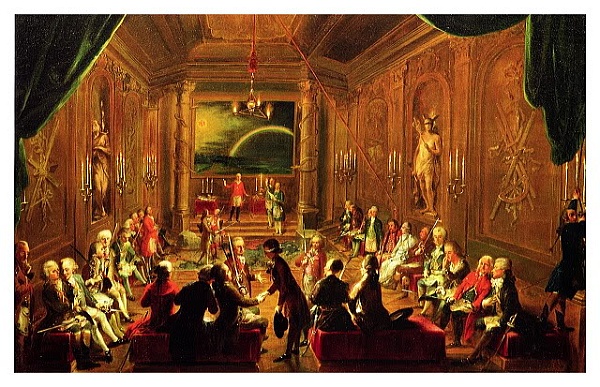
Mozart in Vienna Lodge
On 14 January 1786, Mozart joined the new lodge The Crowned Hope. But he was not present at the opening ceremony and later he seldom attended their meetings. During this period, Mozart seldom wrote Masonic music.
Mozart belonged to the society where the llluminati still dominated. Only during the last year of his life, 1791, did he produce new pieces of music for the freemasons. This music contained secret codes and moods. Mozart desired true friends. This was why he became a freemason. All his friends were freemasons. As a very sociable person, Mozart could not be alone and therefore needed friends to associate with.
It has been observed that Mozart, due to his membership in Masonic lodges, found it easier to succeed and to make a name for himself in Europe, since high-ranking Masonic brothers supported him. Nearly half of the members of To True Harmony were aristocrats who helped Mozart, for example Esterhazy. Mozart’s publishers were also freemasons: Pasquale Artaria, Cristophe Torricella and Franz Anton Hoffmeister.
Mozart could always count on the brotherly hospitality of the freemasons, and during his sojourns abroad, he always received economic support and free lodgings. During his travels 1787-1791, the freemasons in Prague and other places helped Mozart in various ways. There is written evidence which proves this. Friends among the freemasons played a crucial role in aiding Mozart financially: Lichnowsky, Franz Hofdemel and Michael Puchberg were among his most important creditors.
Mozart, in his turn, helped other freemasons by acquiring loans for them. In December 1787, Mozart was appointed the imperial chamber composer. This gave him requisitions for greater operas. The Illuminati had become a state within the state. Despite all the prohibitions, they continued with their subversive activities against society. At that time, people lacked experience and resources to protect themselves against freemasonry, which was under the influence of the Illuminati.
The prominent Austrian composer Franz Schubert was not a freemason and he died poor and unappreciated.
As a gifted man, Mozart finally managed to see through the Illuminati’s evil, despite the fact that it appeared to be an angel of light. He intended to protect society by founding a secret society with several of his friends, Die Grotte (“The Cave”). Mozart was well aware of the deadly risk he was taking. Already in April 1787, he wrote in a letter to his father that death was actually the friend of man and that he could never lie down to sleep without thinking that he, despite his youth, might not see another day. (Maynard Solomon, “Mozart”, Stockholm, 1995.)
He wished to expose the magic and the conspiracy of the freemasons to the public. For this purpose he intended to use his opera “Die Zauberflote” (“The Magic Flute”), where Sarastro’s prototype was the Grand Master of the freemasons, Ignaz von Born. Mozart had a perfect memory. Once he had heard a melody, he could play it again later without making any mistakes. “The Magic Flute” (1791) contained many revelations about the secrets of freemasonry.
He used the pyramid of the Illuminati, the all-seeing eye, the temple and other secret symbols. These metaphors were later removed. Mozart also used musical means of expression by contrasting lyrical and tragic themes, elegance and folklore, fantastic details and the solid atmosphere of the orchestra. The opera premiered in the autumn of 1791.
The Illuminati could not forgive Mozart for this. “Requiem” was requisitioned from him anonymously in order to celebrate his own death. He was also paid in advance. The freemasons poisoned the object of their hatred slowly. “Requiem” was finished up to the second-to-last row of verse: lacrymosa dies ilia. Sussmayr finished the opus.
Hermann Ahlwardt claimed in his book “Mehr Licht!” (“More Light”) that Mozart was murdered. He died on 5 December 1791, precisely seven years after his initiation into the Masonic lodge. Salieri was later made the scapegoat. Hermann Wagener’s “Staats- und Gesellschaftslexikon” (volume 18, 1865) confirmed that Mozart was poisoned.
In 1990, several doctors tried to claim that Mozart died of a kidney disease. (Dagens Nyheter, 19 September 1990.) But if he had died a natural death, the freemasons would not have taken away Mozart’s body to prevent an autopsy after he died, or laid him in a grave for the poor together with quicklime.
If Mozart had been faithful to the freemasons, he would have been buried with great honors. His hypocritical “Masonic friends” wept crocodile tears. If “The Magic Flute” had been accepted, those in power would not have sent Johann Emanuel Schikaneder, author of the opera’s libretto, to a lunatic asylum, where he died in 1812.
In Austria, freemasonry was forbidden in the middle of the 1790s. Society managed to keep its ban on this subversive movement until 1918, when the freemasons in Austria came to power with the aid of the false socialist doctrine.
The freemasons continue to smear and depreciate Mozart today (for example Milos Forman in his film “Amadeus”).
